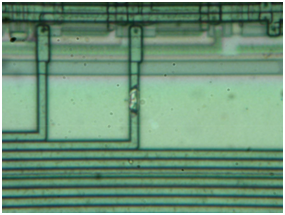 Break Microcontroller ATmega1281V Firmware
Break Microcontroller ATmega1281V Firmware
Break Microcontroller ATmega1281V embedded memory include flash and eeprom, extract firmware from MCU memory after reset the security fuse bit by focus ion beam technique, which is commonly method for microcontroller unlocking;

Break Microcontroller ATmega1281V embedded memory include flash and eeprom, extract firmware from MCU memory after reset the security fuse bit by focus ion beam technique, which is commonly method for microcontroller unlocking
The ATmega1281 provides the following features: 64K/128K/256K bytes of In-System Programmable Flash with Read-While-Write capabilities, 4K bytes EEPROM, 8K bytes SRAM, 54/86 general purpose I/O lines, 32 general purpose working registers when Microcontroller MC68HC11A0FN3 binary recovery.
Real Time Counter (RTC), six flexible Timer/Counters with compare modes and PWM, 4 USARTs, a byte oriented 2-wire Serial Interface, a 16-channel, 10-bit ADC with optional differential input stage with programmable gain, programmable Watchdog Timer with Internal Oscillator, an SPI serial port, IEEE std. 1149.1 compliant JTAG test interface, also used for accessing the On-chip Debug system and programming and six firmware selectable power saving modes if break Microcontroller LPC2132FBD64 firmware.
The Idle mode stops the CPU while allowing the SRAM, Timer/Counters, SPI port, and interrupt system to continue functioning. The Power-down mode saves the register contents but freezes the Oscillator, disabling all other chip functions until the next interrupt or Hardware Reset.
In Power-save mode, the asynchronous timer continues to run, allowing the user to maintain a timer base while the rest of the devMicrocontrollere is sleeping.
The ADC Noise Reduction mode stops the CPU and all I/O modules except Asynchronous Timer and ADC, to minimize switching noise during ADC conversions. In Standby mode, the Crystal/Resonator Oscillator is running while the rest of the devMicrocontrollere is sleeping.
This allows very fast start-up combined with low power consumption. In Extended Standby mode, both the main Oscillator and the Asynchronous Timer continue to run. The devMicrocontrollere is manufactured using Atmel’s high-density nonvolatile memory technology if break Microcontroller MC68HC11F1CFN3 heximal.
The On-chip ISP Flash allows the program memory to be reprogrammed in-system through an SPI serial interface, by a conventional nonvolatile memory programmer, or by an On-chip Boot program running on the AVR core. The boot program can use any interface to download the application.
Firmware in the Boot Flash section will continue to run while the Application Flash section is updated, providing true Read-While-Write operation. By combining an 8-bit RISC CPU with In-System Self-Program mable Flash on a Microcontroller chip, the Atmel ATmega1281 is a powerful Microcontroller that provides a highly flexible and cost effective solution to many embedded Microcontroller.